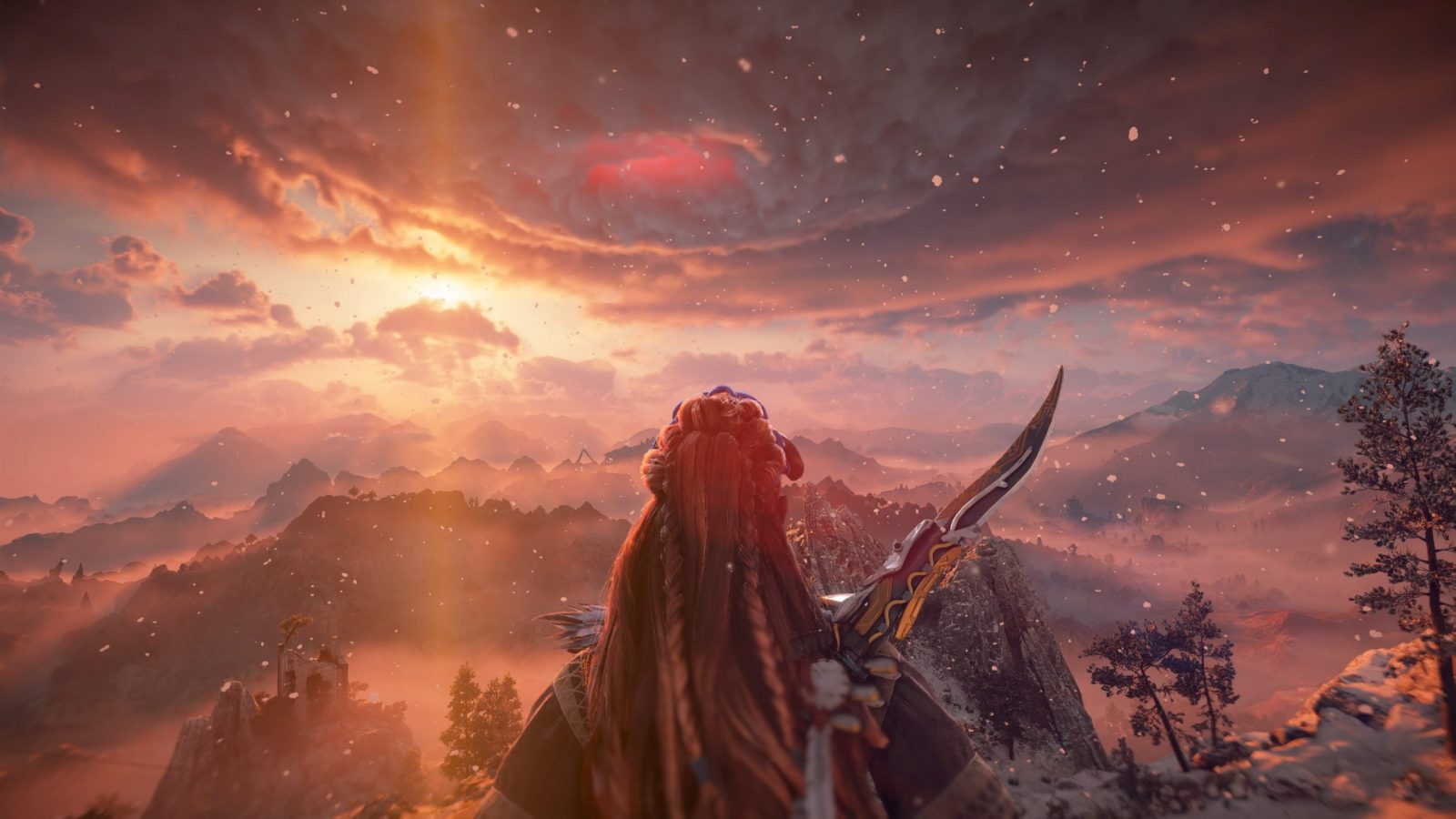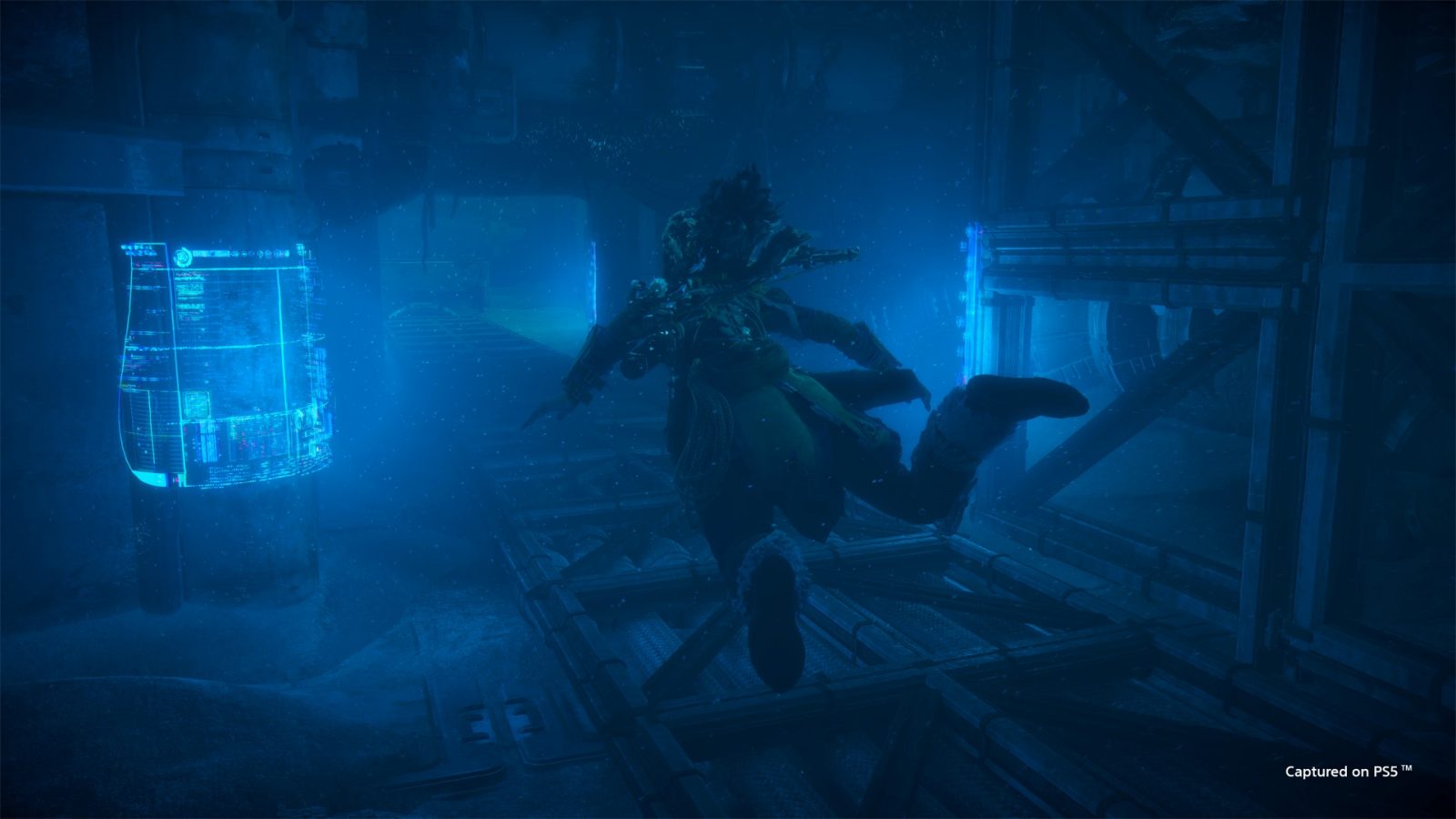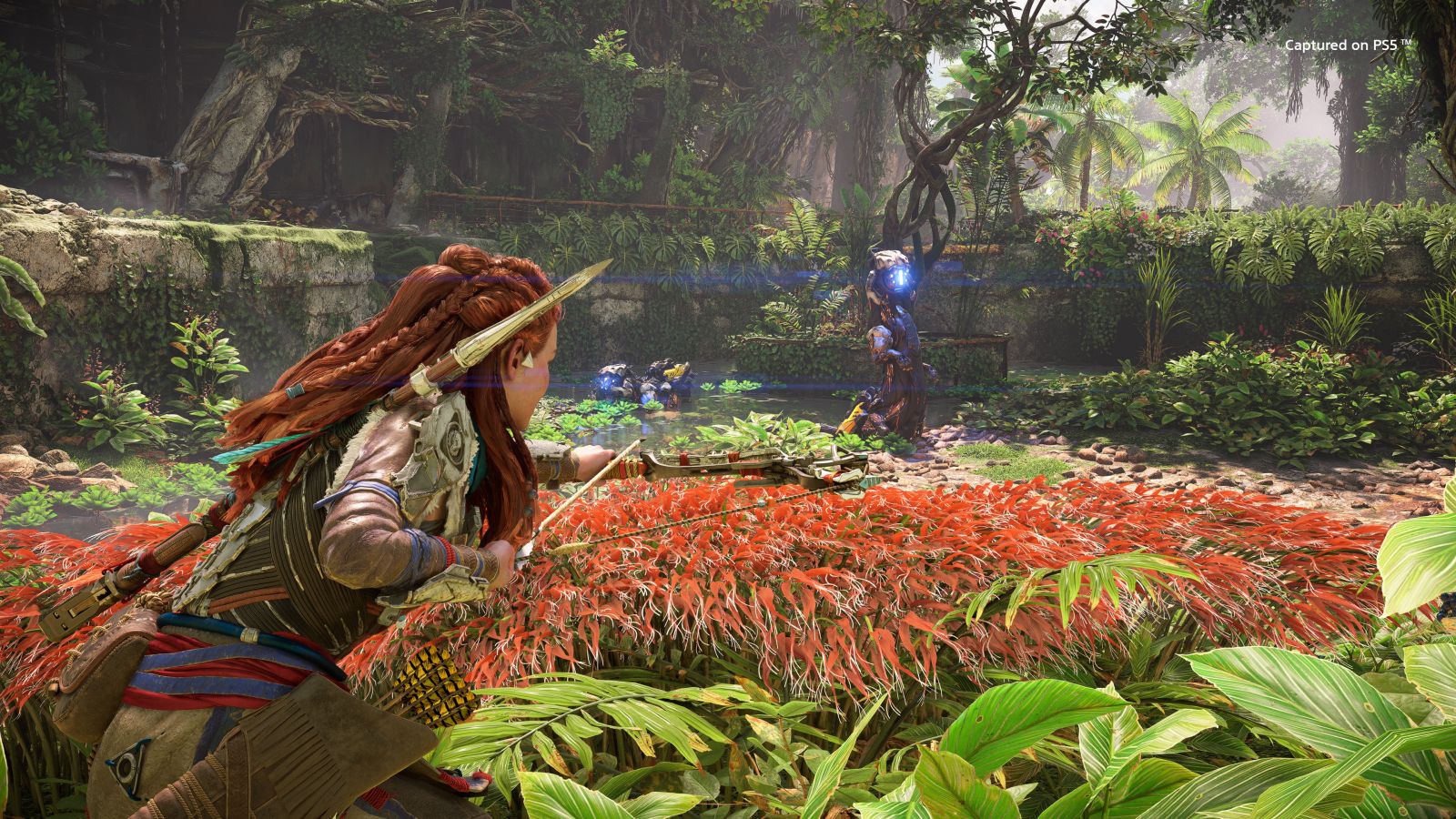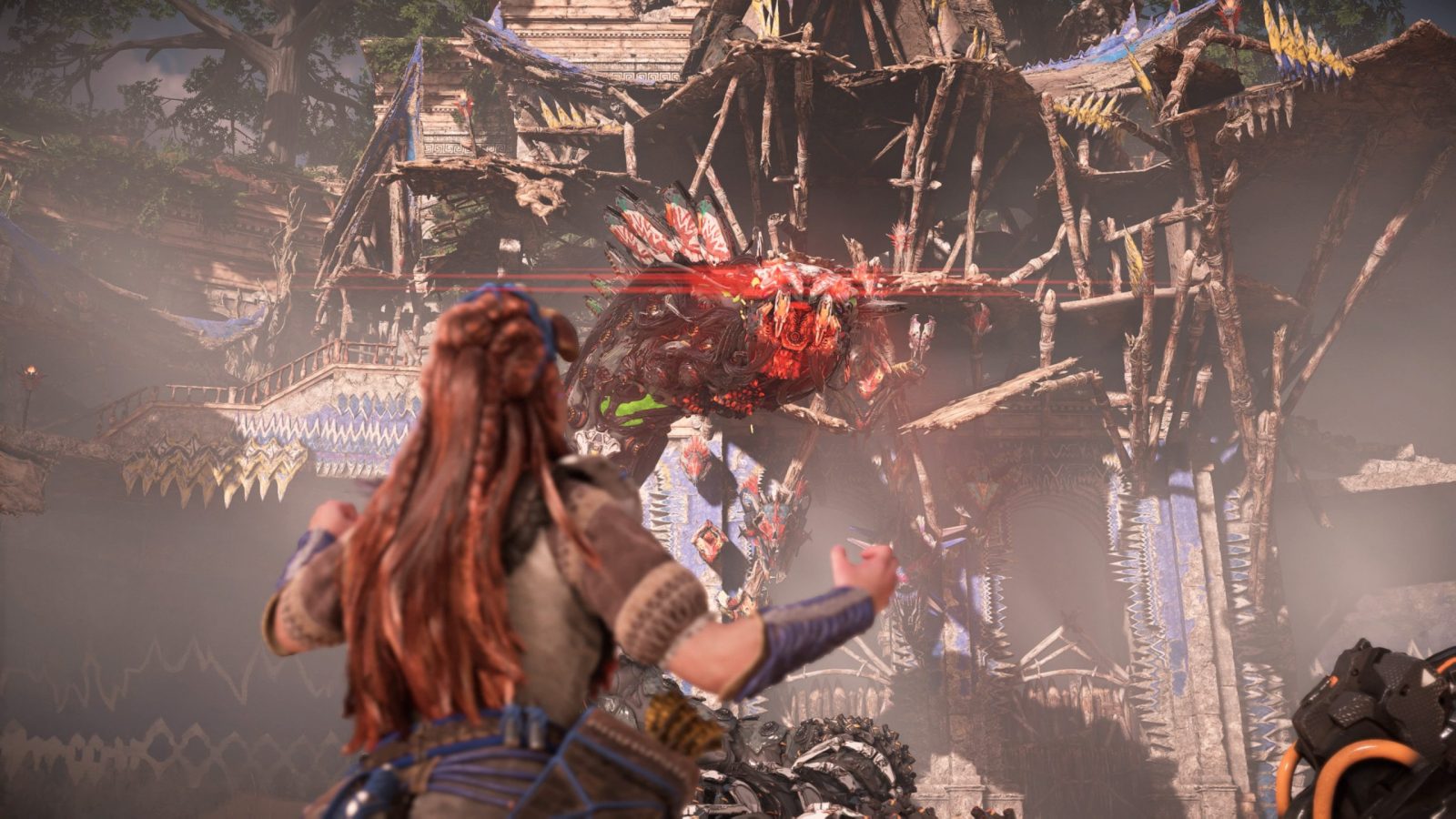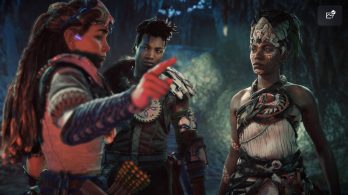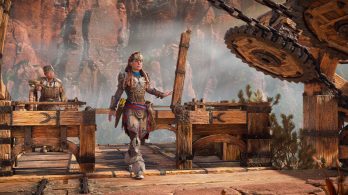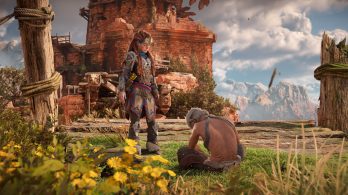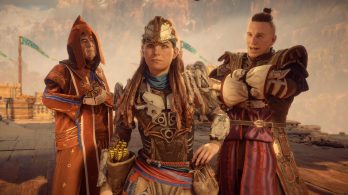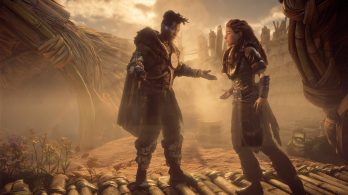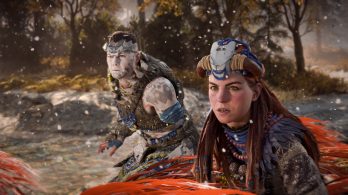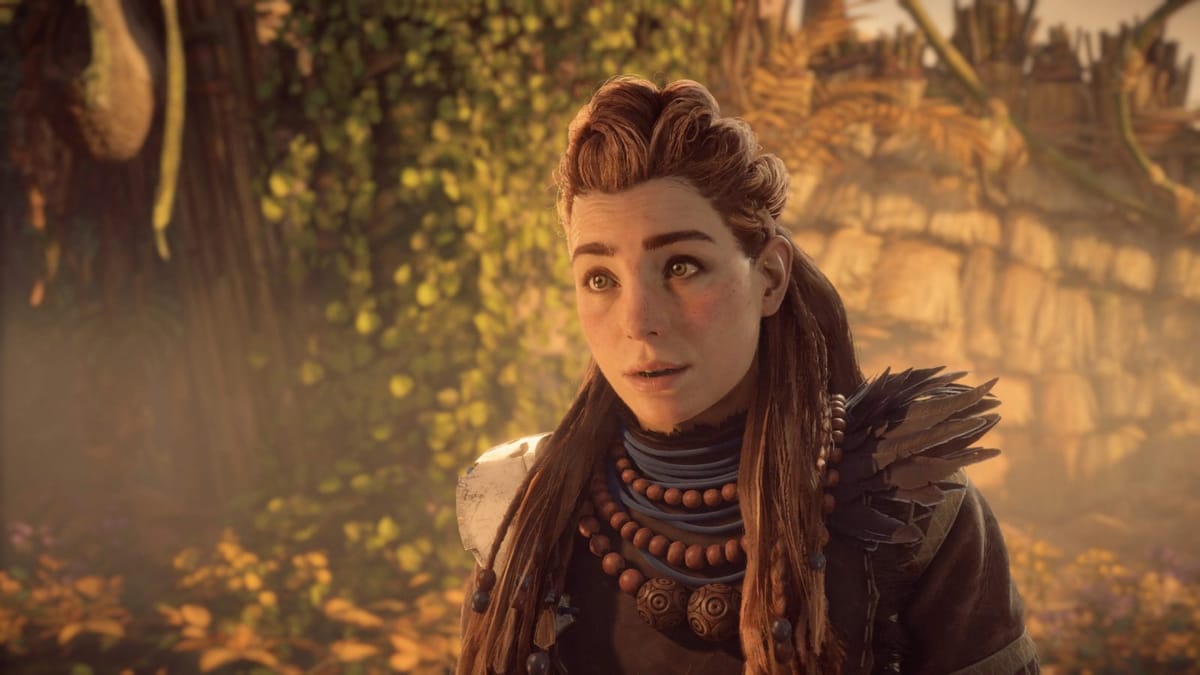
Ever feel like you are alone in the world? How about that you knew everything going on, but no one else could help? This is kind of what happened in Horizon Zero Dawn, where our heroine Aloy grows up an outcast in a post-apocalyptic world, but upon finding a piece of old world technology is launched into a grand mission to not only discover who she is, but her importance to the survival of the Earth. After the battle of Meridian, where Aloy hopes she’s erased the threat to humanity, everything is still falling apart. There are storms, the robots are angrier than ever, a blight is consuming the land, and Earth seems to be on a crash course to destruction. In order to find a solution, Aloy has spent the last six months hunting down GAIA, the AI system built to restore the Earth after Ted Faro’s combat machines wiped out all life. There’s plenty going on here at the beginning of Horizon Forbidden West, but after watching the credits roll I couldn’t have been any happier with the direction Guerrilla games sophomore effort has gone, and it’s very easily an early contender for game of the year.
Figuring out where to start with all of this, and of course, not spoiling anything, is certainly a challenge, but let’s have at it. As I mentioned, you start out in a quick tutorial type area with Varl from the original game as a companion. Let me preface with this, this is definitely not what you’ll be playing the entire game. While I know it’s similar to how the original game handled it, having a specific tutorial area, this is a bit off of the pace I expected when starting the game. Maybe it’s just me, but it didn’t work as well as I’d hoped. Then… I climbed a rocket ship and knocked it down to kill three giant robot snakes, and had to fight the one that survived the crash. Yeah, Horizon is absolutely crazy, and it only ups the ante from here.
Jumping from this leads you into another closed off area, but this one is more about exposition than anything, allowing you to chat with people from the first game to hear about what’s been happening in their lives. Of course, you don’t get to stick around. You just found out that Hades isn’t actually dead from your boss battle in the previous game, given that Sylens (played by Lance Reddick) gave you a lance he intentionally designed as an antenna in order to beam Hades to him. It’s time to go to the Forbidden West and track him down, with the side benefit of destroying Hades as well as hopefully finding that copy of GAIA we mentioned earlier.
At least, that’s what I was supposed to be doing. Horizon Forbidden West is massive, and even at the start of the open world map known as The Daunt, you’ll find yourself wanting to go after every icon on the mini-map. The hilarious thing for me was that I spent seven hours doing most everything there, and it’s a tiny part of the map, maybe an 8th to 10th of the full scope of the larger world. The reason it’s so easy to get locked into trying to do all these things lies in the gameplay, along with incredibly well designed side missions and objectives that keep you invested.
The thing about video games, you’re not generally going to do something the other guy hasn’t already done, especially in the open world action-adventure space. We saw that in Horizon Zero Dawn, where plenty of mechanics were borrowed from other games. That being said, it all works if you perfect or make those your own, and Horizon Forbidden West doesn’t mess with an already great formula, instead improving on what they’ve already made fantastic. The example I always like to use is how we’ve all gotten tired of climbing towers and using them to show us what there is to do in a region, but Horizon took the same idea and made it a brontosaurus type dinosaur named the Tallneck. Even further, it’s not enough just to climb it, you’ve got to figure out how to make it onto the big guy in order to hack him and reveal all the map – the creature itself is the puzzle. Taking something and making it feel fresh is something Horizon constantly does, and it’s certainly a big part of Horizon Forbidden West.
This continues on with the weaponry, and honestly, they didn’t do much to it. Even with that being the case though, I find this more not fixing what isn’t broken. Using all of the things available, like the bow or the sling feel great, but they felt great in Zero Dawn. I don’t think they had to do much to tweak these, because they already worked so well, though the lock-on mechanic is a welcome one. The same with crafting on the fly, with the weapon wheel still being super easy to use. Those things, along with the Pokemon-esque system of using specific types of ammo on specific creatures works amazing, so there’s no need to tinker. I know I have a more definitive playstyle with the bows, and the freedom Horizon gives you in equipping weapons allows you to choose the type of Aloy you’re going to be. Want to be more stealthy? Use the tripcaster and traps. Plan to take them head on? The sling and bow are going to be your best friends. Being able to do anything in a game certainly makes it fun, and it also keeps you in it because you want to try new things.
Guerrilla has also pushed to make your melee attack a lot more potent, and their efforts have mostly paid off. Melee is still going to generally be your last resort play, and for good reason, they’re not pushing you to make a melee built character. But melee is now a lot more viable thanks to both upping the speed, as well as adding a few combos to unlock. There aren’t many, but they do in a pinch, and using them charges your staff to energize them with a resonator charge you can shoot at with your bow for a nice extra bit of damage.
While there isn’t much new on the weapons front (although I do love my throwable exploding spear), three new pieces of equipment do give some additional agility to maneuver around the map. Given the wonderful mix of verticality thrown in, the pullcaster and the energy shield turned glider are a boon to your getting around quickly, as well as escaping in dire moments. Being able to use the pullcaster to grapple up to a ledge can save you from an untimely death to a monster dino you somehow missed with your focus, the same with being able to jump off a cliff and glide to safety. While it’s not new, another huge design change has been making the sides of hills/mountains more scalable, with handholds that aren’t just yellow jutting pieces for you to find. It’s not a Breath of the Wild level of being able to climb everything, but it’s definitely a huge step up from Zero Dawn, and it helps with accessibility for those who need it.
The last piece of equipment is the diving mask, and it changes the game exponentially once you get it. Forbidden West can feel a bit like a metroidvania in that respect, with sections in The Daunt walled off from exploration because of these missing pieces. That in perspective, the handling of underwater adventuring is positive, even if combat is non-existent. The story mission where you’re hunting for more of GAIA (I’ll keep it brief to let you have fun with it for yourself), is mostly how I’d want anything underwater approached. Water levels are generally disliked (looking at you Water Temple), but Guerrilla’s design being enjoyable elevates it. In all fairness, all they had to do was make me not hate it and it would be a win.
As for upgrading yourself and your arsenal, you’ll spend a lot of time collecting things in the world and gaining skill points from completing activities, just like Zero Dawn. There are a few things I really like here, and I’ll start with the expanded skill tree. There are 162 skills on a tree that reminds you of the constellations from Skyrim, dividing them into six different categories. It really depends on how you want to play the game, but in any case you have the opportunity to earn plenty of points relatively quickly, although when I rolled the credits I’d only earned 69 of the 162. Included in these are the valor abilities, which are more or less a cool special move that gives you a boost in tight spots. I can’t say I used them much, but occasionally in a boss fight Ranged Master would come in handy to add extra damage on my bow shots.
Besides this, you’ll be crafting away at workbenches after collecting the things you need. The good news in Forbidden West, there is a stash system now, and even better it automatically takes in the things you collect past your carry limit. All you have to do is run by it and click a button to restock, and it’s now a feature I’ll demand in open world games. Moving into crafting, unlocking new levels on weapons and outfits allows better stats, but also opens slots for coils (which were in the last game) and perks for the weapon. For instance, the Pyre Hunter Bow I have shoots fire arrows, but upgrading it added 10% burning enemy damage. It’s the little things that count, and Guerrilla has done a stupendous job refining what was already great into something fantastic.
Of course, the equipment and skills allow you to do a ton in this world, and explore each of these incredible environments. There’s the beachside aura of the Golden Gate Bridge, the sandy plains of future Las Vegas, the quiet forests of what I assume is Oregon, all blending together in a magnificent juxtaposition of our modern world, and the ruined one we see before us. Zero Dawn did it well, but something about Forbidden West feels even bigger and more alive. I’m sure being able to take advantage of the PlayStation 5’s processing helps, but given this is a cross-gen title most of this is going to exist on PlayStation 4 as well. It’s just so well designed, with the beauty of the setting, the characters, the machines, and the wildlife so vibrant and inviting. That’s not to forget the incredible lighting either, which makes it all look so good.
The environments are great, and what they house is even better. We all know why you’re buying Forbidden West, because you want to fight a bunch more of those insane robot dinosaurs. We found out in the first game that all of these creatures (I know they aren’t all dinos) have a purpose, being created by the Hephaestus function of GAIA to terraform the Earth for humanity. When GAIA exploded herself to keep a mysterious signal from causing everything to be wiped clean, all of these functions were thrown off into different areas and started doing their own thing, albeit in somewhat of a psycho way because they weren’t ever supposed to operate on their own. Well, there are even more in the world, along with your favorites from the first game like Watchers, Chargers, and of course our favorite, the Thunderjaw. Some are pretty simple, the Bristlebacks seem like ox-like animals, but they continue to grow more complex, like in your run-in with the Slitherfang. Before the end of the game you’ll fight multiple new boss creatures, and it’s amazing seeing the range and creativity Guerrilla brings to Forbidden West. I wasn’t sure how they’d outdo themselves in this area, but they did.
Similarly, the different tribes and human enemies you encounter in Forbidden West have more range, enabling the world to be multi-dimensional. It somewhat reminds me of the factions in Fallout New Vegas, not everyone is going to want to kill you, and many will be looking for favors from you. I never encountered anyone friendly that I could tick off mind you, so you’ll know your enemies from your buddies, but some rendezvous won’t start cleanly. I am a bit disappointed in the missing ability to have to choose my friends and enemies, especially with decision making a part of dialogue, but I understand it’s harder for a writer to make a definitive narrative under those circumstances.
With that in play, you’ll be handling a bunch of different side quests for plenty of different people, and it’s been handled with aplomb by Guerrilla. One of the criticisms Horizon Zero Dawn received was past the main characters and story, the things on the side were very… plastic. By that, I mean that the character models for side people were off, the voice acting seemed to be an afterthought, and there wasn’t any personality to it. Guerrilla seems like they took that to heart, because many of these quests I’ve encountered in the sequel have an energy that was missing from the original. This is especially present in the face capture, which aren’t a bunch of blank expressions, and with fantastic performances by the cast, such as Ashly Burch (Aloy), John MacMillan (Varl), and John Hopkins (Erend) . Not only have they outdone themselves in bringing the NPCs to life, but they feel personable and part of your adventure as opposed to a tacked on mission.
This extra effort bleeds into everything. The care and passion poured into creating a cast that feels like living breathing people, not just NPCs. Talking with a random Utaru farmer whose convoy has been attacked by machines pulls an emotional response from you with his profuse thanks for saving their lives. There were moments like this in Horizon Zero Dawn, but it doesn’t compare to the thorough nature in Forbidden West. Another step up has been the more prevalent characters, with Erend, Varl, and the others you’ll befriend, feeling like the close companions they’re supposed to be. I’d have finished Forbidden West much quicker if I hadn’t spent so much time conversing with them at my base, and the dialogue has received major upgrades to leave you searching for moments to explore the backstory of the characters.
Speaking of “finishing Forbidden West”, in the midst of running around doing all sorts of things, Guerrilla doesn’t skimp on your foremost assignment. The entire planet hangs in the balance, and the discoveries Aloy is going to make as you attempt to save everyone are going to blow you away. I thought what we found out in Zero Dawn was an insanely creative and entertaining story, but the revelations you get as you progress through the Forbidden West raise the stakes for everything and everyone. One thing is certain, Guerrilla doesn’t pull any punches. Every time I thought I was done reeling from one story beat, another would swoop in to make my jaw drop. It’s not just the shock factor either, each piece of the puzzle is extremely satisfying, and you’ll generally sit there wondering how in the world they came up with it. The final third of the game in particular is inconceivably packed with details, going from 0-60 with constant new discoveries. All that in the rearview, Horizon 3 is TOTALLY set up, so don’t worry about our favorite Nora warrior going anywhere.
The campaign aside, there’s a bunch of different activities to do. Besides the obvious side missions, returning from Zero Dawn are things like Cauldrons, Hunting Grounds, Rebel Camps, and the like. In Forbidden West there’s a couple of other things like errands, salvage contracts, the melee pit, and others. One of the things I really like is the addition of being able to create jobs to do upgrades for your weapons or outfits. Remembering all the things necessary to improve what you’re working on can be tough, so adding a recipe system like this is appreciated. I put about 22-25 hours into my run of the campaign, so if you add everything else to the equation you’re probably looking at 50 hours minimum to do every little thing, and I’m sure plenty of people will end up with 80+ in.
As per any review, I like to make sure and let you know if anything is a real issue. Honestly, the technical prowess of Guerrilla comes through nicely. The game runs extremely well in performance mode and quality, with largely minimal loading times. There were a few problems I did run into, but once the day one patch arrived for us last week those issues disappeared. You’ll still get some pop-in, but it’s much less pronounced.
One last thing to talk about, the Dualsense and the wealth of accessibility. First with the controller, I like what Guerrilla has done, but it does feel like they played it safe in using the adaptive triggers. I bring up Kena: Bridge of Spirits a lot when it comes to how to handle a bow in a game, and Aloy’s just isn’t as intense as Kena’s. It still works well enough, and the haptic feedback is decent. Secondly with accessibility, the menu holds a fortune of adjustments you can utilize, from multiple controller presets, to auto-sprint, to ease of waypoints. Another huge benefit is co-pilot, allowing a second person to take the reins using a second controller to assist someone in playing what can be a complicated game.
Horizon Forbidden West
Phenominal
It’s not just that Horizon Forbidden West is bigger, it’s better. Guerrilla had already crafted an incredible title in Zero Dawn, but they’ve graduated into building an immaculate one in Forbidden West. Its strengths are taken to new heights, tuned to being the best they can be, and what were once weaknesses transform into pillars the series can build on. Besides a few minor technical issues, Horizon Forbidden West is the perfect example of what you want a sequel to an already great game to be, and it’s certainly a challenger for best game in 2022.
Pros
- A massive living, breathing world
- An emotional story that keeps you captivated the whole way through
- Freakin’ robot dinosaurs (and creatures)
- An incredible sandbox of combat and exploration
- Absolutely gorgeous
Cons
- Minor technical problems


